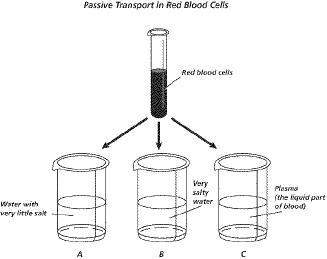
100 points, brainliest, and free points if you answer all correctly
1.use the diagram to answer the question.
what would happen if some of the red blood cells were placed in beaker b?
water would move into the cells by osmosis, causing the cells to shrink.
water would move out of the cells by osmosis, causing the cells to shrink.
water would move into the cells by osmosis, causing the cells to swell.
water would move out of the cells by osmosis, causing the cells to swell
2.
use the diagram to answer the question.
what would happen if some of the red blood cells were placed in beaker a?
water would move into the cells by osmosis, and the cells would swell.
water would move out of the cells by diffusion, and the cells would shrink.
water would move out of the cells by osmosis, and the cells would shrink.
water would move into the cells by diffusion, and the cells would swell.
3.
what would occur if some of the red blood cells were placed in beaker c? recall that red blood cells normally float in plasma.
the concentration of water inside and outside the cells would be equal, so no osmosis would occur.
the concentration of water inside and outside the cells would be equal, so no diffusion would occur.
the concentration of water inside the cells would be less than outside, so the cells would swell.
the concentration of water inside the cells would be greater than outside, so the cells would shrink.
4.
what is a function of water in a cell?
producing lipids and carbohydrates
assisting in the production of proteins
the cell move and grow
preventing rapid temperature changes
5.
the cell membrane and water are both involved in
directing the cell’s activities and functions
the movement of materials into and out of the cell
preventing chemical reactions from taking place
making and packaging proteins for the cell
6.
the cell membrane and water are both involved in
directing the cell’s activities and functions
the movement of materials into and out of the cell
preventing chemical reactions from taking place
making and packaging proteins for the cell
7.
which are types of passive transport?
osmosis and diffusion
diffusion and engulfing
transport proteins and osmosis
engulfing and transport proteins


Answers: 3
Another question on Physics

Physics, 22.06.2019 07:50
Calculate the ratio of h+ ions to oh– ions at a ph = 6. find the concentration of h+ ions to oh– ions listed in table b of your student guide. then divide the h+ concentration by the oh– concentration. record this calculated ratio in table a of your student guide. compare your approximated and calculated ratios of h+ ions to oh– ions at a ph = 6. are they the same? why or why not? record your explanation in table a. what is the concentration of h+ ions at a ph = 6? mol/l what is the concentration of oh– ions at a ph = 6? mol/l what is the ratio of h+ ions to oh– ions at a ph = 6? : 1
Answers: 1

Physics, 22.06.2019 09:00
An open cart is moving along a straight frictionless horizontal track. when rain starts falling vertically into the cart, what happens to the speed of the cart?
Answers: 3

Physics, 22.06.2019 10:00
What is the temperature in degrees celsius of a substance with a tempature of 49k
Answers: 2

Physics, 22.06.2019 15:50
Ryan is examining the energy of the particles in a bar of gold. what is ryan most likely studying?
Answers: 2
You know the right answer?
100 points, brainliest, and free points if you answer all correctly
1.use the diagram to...
1.use the diagram to...
Questions






















